Introduction
During a wildfire, thousands of embers can rain down on your roof and pelt the side of your home like hail during a storm. If these embers become lodged in something easily ignited on or near your house, the home will be in jeopardy of burning. Embers coming into contact with flammable material is the major reason why homes are destroyed during wildfire.
Common materials that become embers during wildfire include pine cones, branches, tree bark, and wooden shingles. Depending on fire intensity, wind speed, and the size of materials that are burning, embers can be carried more than a mile ahead of the fire. Consequently, even homes located blocks away from the actual flame front are vulnerable to ignition and complete destruction.
By being ember aware and taking action ahead of time, a homeowner can substantially reduce the ember threat. Your home CAN survive when the embers arrive.
Will YOUR home survive when the embers arrive?
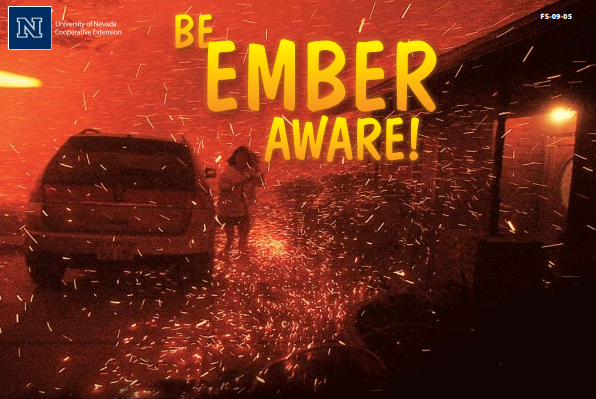
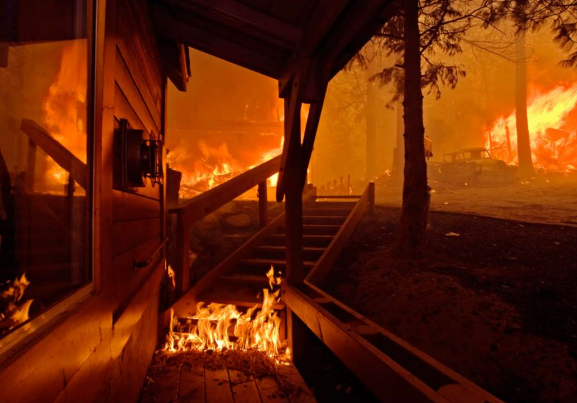
Where is this home vulnerable to ember attack?
- Wood Roof
- Replace wood shake and shingle roofs with fire-resistant types such as composition, metal and tile.
- Roof Openings
- Plug openings in roof coverings, such as the open ends of barrel tiles, with non-combustible materials.
- Roof Debri
- Routinely remove plant debris, such as pine needles, leaves, branches and bark, from the roof.
- Skylights
- Replace plastic skylights with types constructed of double-pane glass. One of the panes should be tempered glass. Close skylights if wildfire is threatening.
- Spark Arrester
- Install an approved spark arrester on chimneys.
- Windows
- Replace single-pane, non-tempered glass windows with multiple-pane, tempered-glass types. Close all windows if wildfire is threatening.
- Vents
- Cover attic, eave and foundation vents with 1/8-inch wire mesh or install new vent types designed to prevent ember entry. If wildfire is threatening, consider covering vent openings with pre-cut plywood or aluminum foil folded several layers thick and stapled.
- Rain Gutters
- Keep rain gutters free of plant debris during fire season. Consider using rain gutter covers to reduce maintenance.
- Siding
- Fill gaps in siding and trim materials with a good quality caulk and replace poor condition building materials.
- Woodpiles
- Move firewood stacks and scrap lumber piles at least 30 feet from the house or other buildings.
- Patio Furniture
- Place combustible patio furniture, such as lounges, tables and hammocks, inside the house or garage if wildfire is threatening.
- Deck Boards
- Replace deck boards that are less than one inch thick or that are in poor condition with thicker, good condition boards. Use metal flashing between the deck and the house.
- Deck Debris
- Remove plant debris from the gaps between deck boards, the gap between the deck and house, and lying on top of the deck.
- Porch and Deck Accessories
- If wildfire is threatening, remove combustible materials from the porch and deck including newspapers, wicker baskets, door mats, pine cones and dried flower arrangements, and place BBQ propane tanks indoors.
- Under the Deck
- Remove plant debris, wood piles and other easily ignited materials from under decks. Consider enclosing the open sides of the deck with siding materials that are properly vented or 1/8-inch wire mesh to reduce maintenance and deter ember entry. Do not use wooden lattice to enclose decks.
- Flowerboxes
- Remove wooden flowerboxes from beneath windows if wildfire is threatening.
- Eaves
- Cover open eaves with sheathing, such as plywood or fiber-cement board. Use tongue and groove joints or other intricate joint types and don’t use butt joints.
- Flowerbeds
- Replace wood mulches with noncombustible types and remove plant debris, including dried grass and flowers, dead leaves and dead branches from flowerbeds next to the house, other buildings and next to wooden fences. Replace ornamental junipers with low-growing deciduous shrubs or flowers under irrigation.
- Vehicles
- Close vehicle windows. Back into the garage and close the garage door or park away from the house.
- Garage Door
- Adjust garage doors to achieve as tight a fit as possible with the door frame. Consider using trim around the garage door opening to reduce the size of gap openings. Close the garage door if wildfire is threatening.
- Garbage Cans and Recycling Bins
- Use garbage cans covered with tight fitting lids near the house or other buildings. Move newspaper recycling bins indoors.
- Wooden Fences
- Maintain wooden fences in good condition and create a noncombustible fence section or gate next to the house for at least five feet.
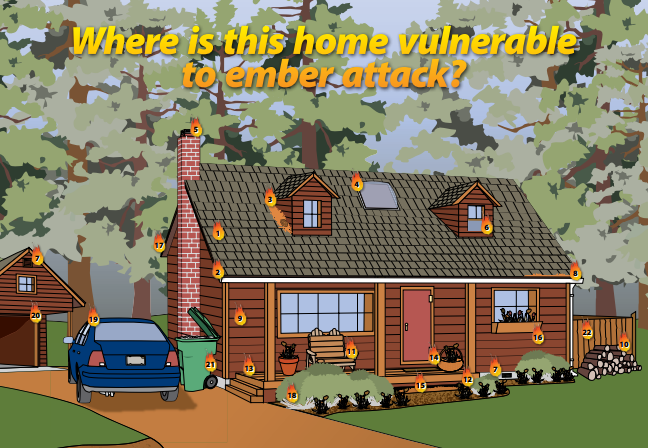
A wooden house, a small pile of pine needles and glowing embers were all that it took to destroy this home.
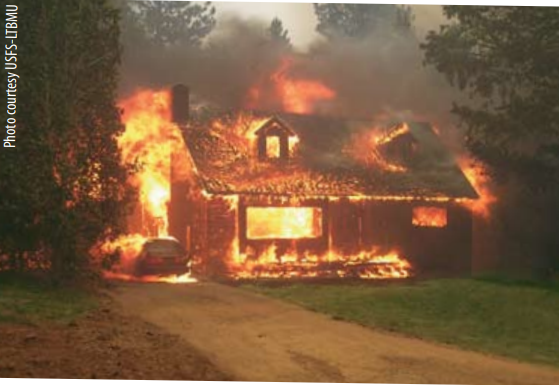
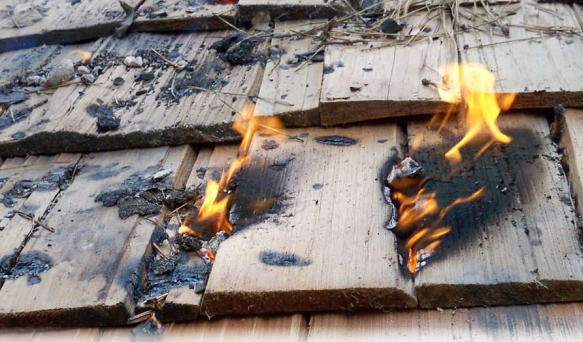
This house was ignited by burning embers landing on vulnerable spots. Notice the adjacent forest is not burning. Photo courtesy USFS-LTBMU.
Smith, Ed, Sistare, Sonya
2009,
Be Ember Aware,
Extension | University of Nevada, Reno FS-09-05


